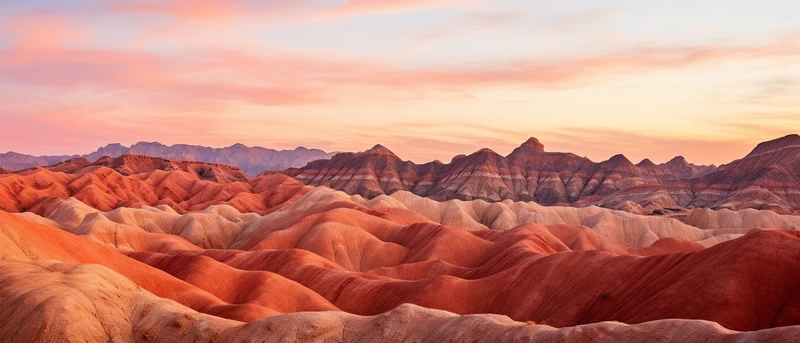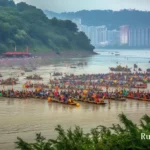China is a vast and diverse country with numerous natural wonders, many of which are lesser-known yet equally breathtaking as the more famous sites. Here are a few hidden gems you might consider for your adventure:
1. Zhangye Danxia Landform, Gansu Province
The Zhangye Danxia Landform, located in Gansu Province, is one of China’s most extraordinary natural wonders. Here are some key details to help you plan your visit:
Unique Geography: This area is renowned for its colorful rock formations, a result of mineral deposits and red sandstone eroding over millions of years.
Visual Splendor: The landscape is characterized by incredible waves of color, creating a surreal, almost painting-like view. The colors are particularly vivid after rain or during sunrise and sunset.
Best Time to Visit
- Late Spring or Early Autumn: These seasons offer the best combination of pleasant weather and the most vibrant colors in the rock formations.
- Avoid Harsh Weather: Summers can be very hot, and winters quite cold, so visiting during the transitional seasons is recommended for comfort.
Things to Do
- Photography: It’s a paradise for photographers, thanks to the ever-changing light and shadow play on the colorful hills.
- Hiking and Exploration: There are several viewing platforms and walking trails that allow you to explore the area and get different perspectives of the landscape.
Tips for Visiting
- Stay Hydrated: The area can be dry, so carry enough water.
- Sun Protection: Use sunscreen, hats, and sunglasses to protect against the strong sun.
- Respect the Environment: Stay on marked trails to preserve the delicate formations.
- Local Guides: Consider hiring a local guide for in-depth knowledge and to find the best spots for views and photos.
- Accommodation: Stay in Zhangye city, as it’s the closest urban center with a range of accommodation options.
Cultural Aspects
- Nearby Attractions: Combine your visit with a trip to the nearby Mati Temple, which features grottoes and Buddhist art.
- Local Cuisine: Try some local Gansu dishes, which are often hearty and flavored with local spices and herbs.
Visiting the Zhangye Danxia Landform is a chance to witness one of nature’s most extraordinary art displays. It’s a must-see for nature lovers and those interested in geological wonders. Remember to tread lightly and respect this delicate and beautiful landscape.
2. Tiger Leaping Gorge, Yunnan Province
Tiger Leaping Gorge, located in the Yunnan Province of China, is one of the deepest and most spectacular river canyons in the world. Here’s what you need to know to plan a visit:
Stunning Geography: The gorge is a breathtaking natural wonder, where the Jinsha River (the upper course of the Yangtze River) is flanked by towering cliffs and majestic mountain peaks.
Name Origin: It’s said that the name comes from a legend where a tiger leaped across the river at its narrowest point to escape hunters.
Best Time to Visit
- Spring and Autumn: These seasons offer the best weather conditions – mild temperatures and minimal rainfall. The scenery is especially beautiful with either spring blossoms or autumn foliage.
Trekking and Activities
- Hiking Trails: The high path (“the high road”) offers incredible views and can be challenging. The trek usually takes 2-3 days, with guesthouses along the route for overnight stays.
- Lower Trail: Less strenuous, this path is closer to the river and is accessible for most fitness levels.
- Local Villages: The trail passes through several Naxi villages, where you can experience local culture and hospitality.
Safety and Preparation
- Physical Fitness: Ensure you’re in good physical condition, as the high trail can be quite demanding.
- Gear: Wear sturdy footwear and bring layers of clothing, as weather can change quickly.
- Guides: While the trail is well-marked, hiring a local guide can enrich your experience and provide additional safety.
- Altitude Awareness: The gorge is at a high altitude, so take time to acclimatize and watch for signs of altitude sickness.
Respect the Environment
- Leave No Trace: Be mindful of your environmental impact. Carry out all trash and respect the natural landscape.
- Cultural Sensitivity: Respect local customs and traditions of the Naxi people.
Nearby Attractions
Lijiang: Before or after your trek, explore the ancient town of Lijiang, a UNESCO World Heritage site with a rich history and unique architecture.
3. Kanas Lake, Xinjiang Uygur Autonomous Region
Kanas Lake, located in the Xinjiang Uygur Autonomous Region, is a hidden gem nestled in the Altai Mountains. It’s a place of extraordinary natural beauty and cultural richness. Here’s what you need to know for planning a visit:
- Natural Beauty: Kanas Lake is known for its pristine waters and stunning alpine scenery. The lake is surrounded by dense forests and is home to diverse wildlife.
- Color-Changing Lake: The lake is famous for its changing colors, which can vary from deep green to azure blue, often attributed to different seasons and weather conditions.
Best Time to Visit
- Summer and Early Autumn: These seasons offer the most favorable weather for exploring the area. The landscape is lush in summer, while early autumn brings a palette of vibrant colors.
- Winter: The region turns into a snowy wonderland, though the harsh weather may pose challenges for travel.
Activities and Attractions
- Boat Trips: Enjoy a boat ride on the lake to fully appreciate its beauty and serenity.
- Hiking: There are numerous trails around the lake, offering breathtaking views and opportunities to spot wildlife.
- Cultural Experiences: The region is inhabited by various ethnic groups, including Kazakhs and Mongolians. Engaging with local communities can offer insights into their unique cultures and traditions.
Tips for Visiting
- Prepare for Varied Weather: Weather can be unpredictable, so bring layers of clothing.
- Altitude Considerations: The lake is at a high altitude, so acclimatize appropriately to avoid altitude sickness.
- Respect the Environment: The area is ecologically sensitive. Stick to marked trails and avoid disturbing wildlife.
- Local Cuisine: Try local dishes, which often feature lamb and dairy products, reflecting the nomadic lifestyle of the region.
Nearby Attractions
Hemu Village: A picturesque village nearby, known for its traditional wooden houses and stunning natural surroundings.
Altai Mountains: Explore the broader region of the Altai Mountains, which offer a wealth of natural and cultural experiences.
4. Wulingyuan Scenic Area, Hunan Province
Wulingyuan Scenic Area in Hunan Province is a remarkable natural wonder that offers an otherworldly landscape. It’s a UNESCO World Heritage site and is famous for inspiring the Hallelujah Mountains in the movie “Avatar.” Here’s what you need to know for your visit:
- Quartzite Sandstone Pillars: The area is renowned for over 3,000 towering quartzite sandstone pillars, some reaching over 1,000 feet in height.
- Rich Biodiversity: Wulingyuan boasts dense forests with a rich variety of plant and animal life, making it a haven for nature enthusiasts.
Best Time to Visit
- Spring and Autumn: These seasons offer the most pleasant weather, with mild temperatures and the least rainfall. Spring brings lush greenery and blooming flowers, while autumn is adorned with vibrant fall colors.
- Avoid Heavy Tourist Seasons: Try to avoid national holidays and peak summer months, as the area can get crowded.
Activities and Attractions
- Hiking and Exploration: There are numerous trails and paths allowing for exploration of the pillars, valleys, and forests.
- Bailong Elevator: This glass elevator built onto the side of a cliff offers spectacular views as it ascends.
- Tianzi Mountain: Known for its stunning scenic vistas, it’s a must-visit within the area.
- Avatar Hallelujah Mountain: A pillar renamed for its resemblance to the floating mountains in “Avatar.”
- Golden Whip Stream: A serene and picturesque walking path alongside a crystal-clear stream.
Tips for Visiting
- Wear Comfortable Footwear: There’s a lot of walking, often on uneven terrain.
- Weather Preparedness: The weather can change quickly; pack rain gear and layers.
- Environmental Respect: Stay on marked trails to protect the fragile ecosystem.
- Photography: Bring a camera! The landscape offers phenomenal photo opportunities, especially in the early morning and late afternoon light.
Nearby Attractions
Zhangjiajie City: Explore the nearby city for additional cultural and culinary experiences.
Fenghuang Ancient Town: A well-preserved town that showcases traditional Chinese architecture and culture.
5. Mount Wuyi, Fujian Province
Mount Wuyi, located in the northern part of Fujian Province, China, is a UNESCO World Heritage Site celebrated for its scenic beauty, rich biodiversity, and cultural significance. Here’s what you need to know for planning a visit:
- Scenic Landscape: The area is renowned for its dramatic gorges, clear rivers, and a unique range of flora and fauna. It’s characterized by the striking Danxia landform, which is a type of petrographic geomorphology found in China.
- Historical Significance: Mount Wuyi is an important site in the history of Chinese Taoism, Buddhism, and Confucianism, with several ancient temples and monasteries scattered throughout.
Best Time to Visit
- Spring and Autumn: These seasons offer the best climate for exploring. Spring brings lush, blooming landscapes, while autumn dazzles with vibrant fall colors.
- Summer: Although it can be hot and crowded, the summer season sees the mountain draped in a verdant green.
Activities and Attractions
- River Rafting: The Nine Bend River (Jiuqu Xi) offers a serene rafting experience, meandering through the scenic gorges.
- Hiking Trails: There are numerous trails leading to ancient temples, tea plantations, and natural lookouts.
- Cultural Sites: Don’t miss historic spots like the Wuyi Palace and the ancient Song Dynasty tea plantations.
- Tea Culture: Mount Wuyi is famous for its oolong tea, particularly Da Hong Pao. Tea tasting sessions are a must-do.
Tips for Visiting
- Comfortable Footwear: The terrain can be rugged, so sturdy shoes are essential.
- Stay Hydrated: Carry water, especially if hiking or rafting.
- Respect the Environment: Stick to designated trails and respect the natural habitat.
- Local Guides: Consider hiring a local guide to learn more about the area’s history, culture, and ecology.
Nearby Attractions
Ancient City of Fuzhou: Explore the nearby city of Fuzhou for additional cultural and historical experiences.
Fujian Tulou: These are large, multi-story earth buildings of the Hakka people, a UNESCO World Heritage Site, not far from Mount Wuyi.
6. Dongchuan Red Land, Yunnan Province
Dongchuan Red Land in Yunnan Province is a lesser-known but visually stunning destination in China. Famous for its unique and vivid red soil, it’s a paradise for photographers and nature lovers alike. Here’s what you should know for planning a visit:
- Red Soil: The area is characterized by striking red soil, rich in iron and copper, which oxidizes to create a bright, reddish hue. This creates a striking contrast with the green of the crops and the blue sky.
- Agricultural Mosaic: The land is heavily cultivated, and the patchwork of crops and fields adds to the beauty of the landscape.
Best Time to Visit
- Late Spring or Early Autumn: These periods are ideal for visiting Dongchuan Red Land. In late spring, the fields are lush and green, contrasting beautifully with the red soil. Early autumn brings harvest colors, adding another layer of vibrancy.
- Sunrise and Sunset: For photographers, these are the golden hours, offering the best light for capturing the stunning contrasts and colors.
Activities and Attractions
- Photography: The area is a haven for photographers, offering breathtaking landscapes and changing scenes throughout the day.
- Exploration: Walk or drive through the various scenic spots like Damakan, Luoxiagou, and Jinxiuyuan, each offering a unique view of the red land.
- Local Culture: The region is inhabited by several ethnic groups, offering an opportunity to experience diverse local cultures and traditions.
Tips for Visiting
- Transportation: Public transport options are limited, so renting a car or hiring a driver is recommended.
- Accommodation: Stay in the nearby town of Dongchuan or in small guesthouses in the area. Booking in advance is advisable.
- Respect the Land: The area is a working agricultural region, so be respectful of the land and crops.
Nearby Attractions
- Stone Forest: Located near Kunming, the Stone Forest (Shilin) is another unique geological feature worth visiting.
- Kunming: The capital city of Yunnan Province, known for its pleasant climate and beautiful parks.
7. Pamir Mountains, Xinjiang Uygur Autonomous Region
The Pamir Mountains in the Xinjiang Uygur Autonomous Region of China are an awe-inspiring and relatively untouched natural wonder, often referred to as the “Roof of the World.” Here’s what you need to know for planning a visit:
- Rugged Terrain: The Pamirs are characterized by their high peaks, deep valleys, and glacial landscapes. The region is a convergence point of several high mountain ranges, including the Himalayas.
- Cultural Crossroads: The area has a rich cultural heritage, being at the crossroads of various civilizations and trade routes like the ancient Silk Road.
Best Time to Visit
- Summer Months: The best time to visit is during the summer (June to September) when the weather is relatively mild and the mountain passes are accessible. Winters are extremely harsh and challenging in this region.
Activities and Attractions
- Trekking and Mountaineering: The Pamirs offer some of the most challenging and rewarding trekking and mountaineering experiences in the world.
- Karakul Lake: A stunning high-altitude lake known for its crystal-clear waters and the reflection of the surrounding snow-capped mountains.
- Cultural Interaction: The region is home to diverse ethnic groups like the Tajiks, Uyghurs, and Kyrgyz, offering opportunities to experience unique local cultures and traditions.
Tips for Visiting
- Acclimatization: Given the high altitude, it’s essential to acclimatize properly to avoid altitude sickness.
- Permits and Regulations: Some areas in the Pamirs may require special permits due to their proximity to international borders.
- Guided Tours: Considering the remote and challenging nature of the region, it’s advisable to join a guided tour or hire a local guide.
- Preparation: Bring appropriate gear for high-altitude trekking, including warm clothing, as temperatures can drop significantly.
Environmental and Cultural Respect
- Environmental Impact: Be mindful of your environmental impact in this fragile ecosystem.
- Respect Local Customs: The region’s diverse cultures have rich traditions; showing respect and sensitivity to local customs is essential.
Nearby Attractions
Tashkurgan: A historic town along the Karakoram Highway, rich in cultural heritage.
Kashgar: An ancient city known for its vibrant bazaar and historic sites, serving as a gateway to the Pamirs.
Remember, when visiting these natural wonders, it’s important to respect the environment and local customs. Each location offers a unique blend of natural beauty and cultural experience, making them ideal for those seeking off-the-beat path adventures in China.
Always ensure you’re well-prepared for the outdoor activities specific to each region and consider hiring local guides for the best experience and to support the local economy. Enjoy your adventure and the discovery of China’s hidden natural treasures!
If you have any questions or queries, then please feel free to drop us a line.



